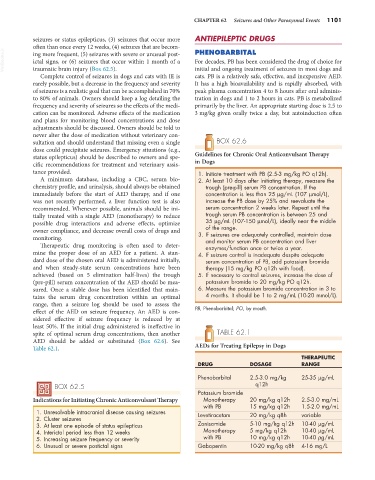Page 1129 - Small Animal Internal Medicine, 6th Edition
P. 1129
CHAPTER 62 Seizures and Other Paroxysmal Events 1101
seizures or status epilepticus, (3) seizures that occur more ANTIEPILEPTIC DRUGS
often than once every 12 weeks, (4) seizures that are becom- PHENOBARBITAL
VetBooks.ir ing more frequent, (5) seizures with severe or unusual post- For decades, PB has been considered the drug of choice for
ictal signs, or (6) seizures that occur within 1 month of a
traumatic brain injury (Box 62.5).
Complete control of seizures in dogs and cats with IE is initial and ongoing treatment of seizures in most dogs and
cats. PB is a relatively safe, effective, and inexpensive AED.
rarely possible, but a decrease in the frequency and severity It has a high bioavailability and is rapidly absorbed, with
of seizures is a realistic goal that can be accomplished in 70% peak plasma concentration 4 to 8 hours after oral adminis-
to 80% of animals. Owners should keep a log detailing the tration in dogs and 1 to 2 hours in cats. PB is metabolized
frequency and severity of seizures so the effects of the medi- primarily by the liver. An appropriate starting dose is 2.5 to
cation can be monitored. Adverse effects of the medication 3 mg/kg given orally twice a day, but autoinduction often
and plans for monitoring blood concentrations and dose
adjustments should be discussed. Owners should be told to
never alter the dose of medication without veterinary con-
sultation and should understand that missing even a single BOX 62.6
dose could precipitate seizures. Emergency situations (e.g.,
status epilepticus) should be described to owners and spe- Guidelines for Chronic Oral Anticonvulsant Therapy
cific recommendations for treatment and veterinary assis- in Dogs
tance provided. 1. Initiate treatment with PB (2.5-3 mg/kg PO q12h).
A minimum database, including a CBC, serum bio- 2. At least 10 days after initiating therapy, measure the
chemistry profile, and urinalysis, should always be obtained trough (pre-pill) serum PB concentration. If the
immediately before the start of AED therapy, and if one concentration is less than 25 µg/mL (107 µmol/L),
was not recently performed, a liver function test is also increase the PB dose by 25% and reevaluate the
recommended. Whenever possible, animals should be ini- serum concentration 2 weeks later. Repeat until the
tially treated with a single AED (monotherapy) to reduce trough serum PB concentration is between 25 and
possible drug interactions and adverse effects, optimize 35 µg/mL (107-150 µmol/L), ideally near the middle
owner compliance, and decrease overall costs of drugs and of the range.
monitoring. 3. If seizures are adequately controlled, maintain dose
and monitor serum PB concentration and liver
Therapeutic drug monitoring is often used to deter- enzymes/function once or twice a year.
mine the proper dose of an AED for a patient. A stan- 4. If seizure control is inadequate despite adequate
dard dose of the chosen oral AED is administered initially, serum concentration of PB, add potassium bromide
and when steady-state serum concentrations have been therapy (15 mg/kg PO q12h with food).
achieved (based on 5 elimination half-lives) the trough 5. If necessary to control seizures, increase the dose of
(pre-pill) serum concentration of the AED should be mea- potassium bromide to 20 mg/kg PO q12h.
sured. Once a stable dose has been identified that main- 6. Measure the potassium bromide concentration in 3 to
tains the serum drug concentration within an optimal 4 months. It should be 1 to 2 mg/mL (10-20 mmol/L).
range, then a seizure log should be used to assess the
effect of the AED on seizure frequency. An AED is con- PB, Phenobarbital; PO, by mouth.
sidered effective if seizure frequency is reduced by at
least 50%. If the initial drug administered is ineffective in
spite of optimal serum drug concentrations, then another TABLE 62.1
AED should be added or substituted (Box 62.6). See
Table 62.1. AEDs for Treating Epilepsy in Dogs
THERAPEUTIC
DRUG DOSAGE RANGE
Phenobarbital 2.5-3.0 mg/kg 25-35 µg/mL
BOX 62.5 q12h
Potassium bromide
Indications for Initiating Chronic Anticonvulsant Therapy Monotherapy 20 mg/kg q12h 2.5-3.0 mg/mL
with PB 15 mg/kg q12h 1.5-2.0 mg/mL
1. Unresolvable intracranial disease causing seizures Levetiracetam 20 mg/kg q8h variable
2. Cluster seizures
3. At least one episode of status epilepticus Zonisamide 5-10 mg/kg q12h 10-40 µg/mL
4. Interictal period less than 12 weeks Monotherapy 5 mg/kg q12h 10-40 µg/mL
5. Increasing seizure frequency or severity with PB 10 mg/kg q12h 10-40 ρg/mL
6. Unusual or severe postictal signs Gabapentin 10-20 mg/kg q8h 4-16 mg/L

